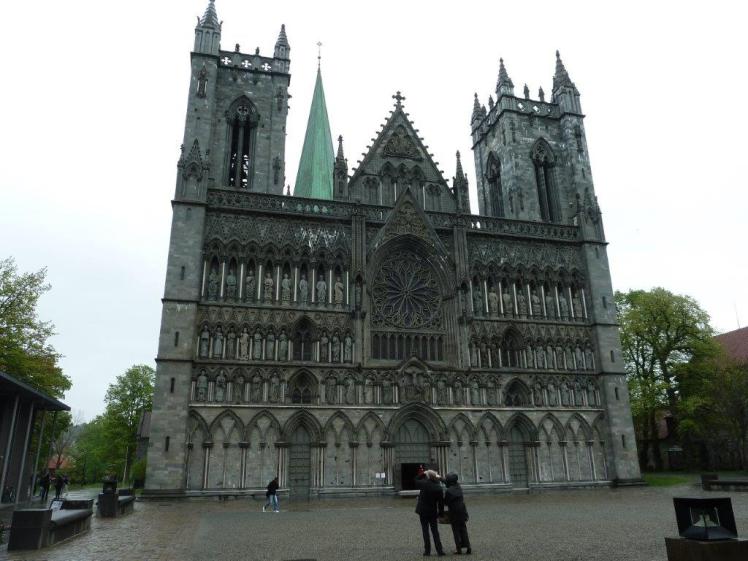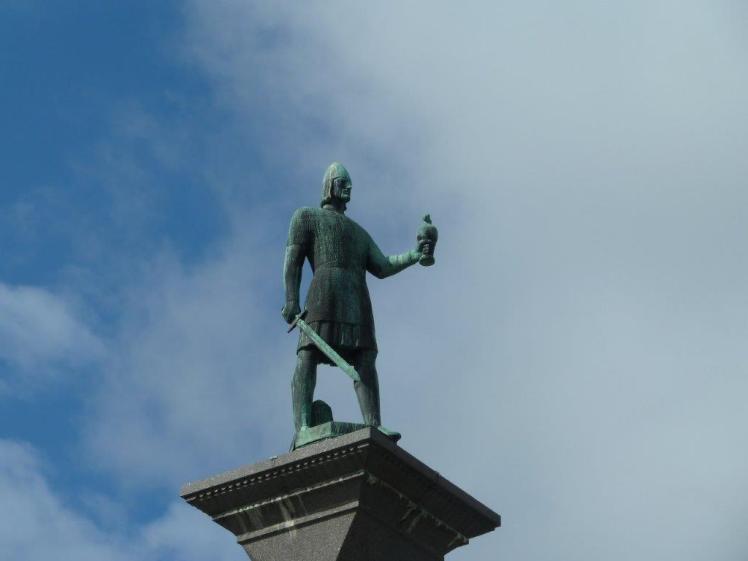Today we’re going to talk about my favourite Viking, King Olafur Tryggvason, or plain Olaf in Norwegian. I make no claims about him being a good or nice Viking, by the way, but a few years ago I found myself accidentally following him around Europe and so I already liked him.
He was a Norwegian king. According to Heimskringla, the saga of the old Norse kings, he was a great-grandson of Harald Fairhair, who I think was the first king of united Norway rather than a local chieftain-king. This didn’t guarantee him the throne by any means – it went from Harald Fairhair to Harald’s son Eric Bloodaxe to Harald’s other song Haakon the Good, to Eric’s son Harald Greycloak to Eric’s brother-in-law Harald Bluetooth. Clear as mud? Here’s a diagram:

The pink lines are marriages, the blue squiggles are the line of succession.
Harald Bluetooth supported an earl called Haakon Sigurdsson, who was killed by his slave/friend, while in hiding in a pigsty from our good friend Olafur. Olafur, being of vaguely royal blood, was prophesied to come and kill the earl – who temporarily succeeded Sweyn Forkbeard. This is the bit I haven’t figured out, because Sweyn then went on to succeed Olafur when this story finishes. So this slave/friend brought the earl’s severed head to Olafur, got himself killed for his pains and Olafur became king.
It’s so much easier when the line of succession runs in a nice straight line down the male line with no deviation.

So we pick up the story with Olafur having just somehow become king of Norway. He chose Trondheim, about halfway up the west coast, as his capital – well, he founded Trondheim as his capital, although it was called Nidaros at the time. It had a big shiny cathedral and was regarded by the old Norse world how the English world used to regard Canterbury; the centre of the Church, the centre of the world, seat of the bishop, end of the pilgrimage. There’s a big statue of Olafur right in the middle of the square outside the hotel I stayed in in 2011.

Olafur was a relatively early adopter of Christianity. He came to England in 994, before he was king, probably scaring the life out of Æthelred the Unready (my actual favourite Anglo-Saxon king, who was only about 12 when he became king and was so badly advised that we still call him Unready today – Unready is an Englishisation of an old Anglo-Saxon word that means ill-advised. 20 years later, Olafur’s father’s cousin’s cousin Sweyn Forkbeard was to stroll in and take the crown of England from him and his son Cnut the Great was to marry Æthelred’s wife. But that’s another story and it’s in the future.
Right. Olafur, Æthelred and Christianity. Olafur came to England, took Æthelred as his sponsor and was confirmed as a Christian (possibly baptised but more likely confirmed) in Andover. Andover’s only about an hour and a half from my house; it’s very surreal to think of Olafur Tryggvason stomping round my home. He left Æthelred with ominous promises to never attack England.
Once he was king, Olafur baptised Leifur Eirikson, who you may remember from the A-Z of Iceland: L for Leifur Eirikson, and then sent him off to Greenland to convert the little colony he established there. Olafur converted Orkney, which was Norwegian at the time. You can still feel his presence there today. Oh, and let’s not forget that conversion is rarely a peaceful pleasant happy process. I said Olafur wasn’t necessarily a nice or good person.
But what has all this got to do with Iceland? This is a Norwegian king going to England, Scotland and Norway. Well, Olafur Tryggvason converted Iceland. He sent a missionary, Þangbrand (to whom history as appended the word “fiery”), to the Alþing in 1000AD. Well, Þangbrand had been in Iceland failing to convert them for a few years by that point. 1000AD is when it worked. I’ll tell you more about the Alþing in two weeks (The A-Z of Iceland: P for Parliament) but for now, the Alþing is the Icelandic Parliament.

Þangbrand’s request for Iceland to convert to Christianity was considered – and when I say “request”, you know I mean there was no choice here and much blood was going to be shed: Þangbrand was eventually exiled for murder. But his mission was accepted by a chieftain called Gizur the White (Tolkien vs Norse names to come on Halloween, the A-Z of Iceland: V for Volsung Saga) and everyone at the Alþing was promptly baptised. Not in the cold water of the Öxará, which is the river that flows into Þingvellir where the Alþing is held. Oh, no. This is Iceland. Vikings don’t do cold water. There’s a perfectly good lake full of hot springs only about fifteen miles away where they can be baptised in nice warm water.

Of course, as to the conversion itself, this is Iceland, as I said. The agreement was to “appear to convert”. Turn your Mjölnir pendant upside down so it looks like a Christian cross. Say “yes, yes, of course I believe in Jesus and have renounced Odin” if anyone asks. Get on with your own life and your own religion when no one important is looking. That’s how things like the Eddas got written down in the thirteen century, when they were supposed to be long-forgotten in favour of the Bible.

That’s about all I’ve got on King Olafur Tryggvason. Founded Trondheim, converted Orkney, converted Iceland using Þangbrand. His reign came to an end at the Battle of Svolder when he was ambushed at sea by Sweyn Forkbeard (king of Denmark), Olaf Skötkonung (king of Sweden) and Eirik Hákonarson, son of that earl Olafur took the throne from a few years ago. It didn’t end well for Olafur, with Sweyn taking back the Norwegian king. Eirik was later to become governor of the majority of Norway. Iceland, meanwhile, had 250ish years of the their Commonwealth/golden age years before coming under the Norwegian throne properly under King Haakon IV (greatx15-grandson of Harald Fairhair and 2nd cousin 14 times removed of our Olafur, if I understand how family trees work. All royalty is related somehow. But that’s another story).